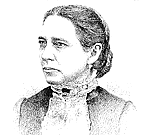 Side by Side: Female
Side by Side: Female| Female: | |
|---|---|
 |
|
Not all men and women kept to their respective roles. In farm families, women sometimes helped with the field work and men sometimes helped around the house. Even in town, women sometimes became part of the labor force. Many women were employed as teachers or factory workers. In the 1870 Illinois census, over 7,000 women were listed in occupations that could be classed as independent businesswomen. Almost 80% were dressmakers, milliners, and seamstresses, occupying trades that still fit within the boundaries of acceptable female behavior at that time. Other prominent women's trades were boardinghouse keeper and teacher of music.
© Illinois State Museum 31-Dec-96